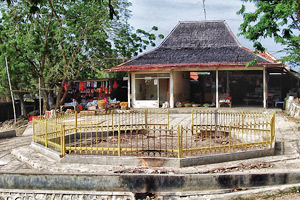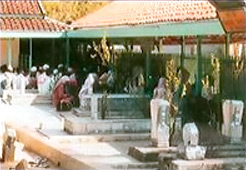
Bangkalan regency
Madura Island is part of East Java that needs a better access. Madura that consist of four regencies has a lot to offer. It has excellent quality of agriculture outputs and beautiful tourism objects and more. The presence of the bridge had expected to improve smoother flow of people, goods and service from and into this island. Mayor impacts had expected to emerge from this facility, be it socially and economically. The Suramadu Bridge that connects Surabaya and Madura Island has expected to complete in 2007, extending 5.43 km with 28.10 m width.
The sea crossing from East Java to the small island of Madura takes just half an hour. Measuring about 160 km in length and about 40 across at it s widest point, Madura support a population of close to 3 million inhabitants, most of whom are farmers or fisherman.
The most famous attraction of this island is the annual bull racing (kerapan sapi), which takes place during the dry season in August – September. These exiting and colourful tournaments consist of a race between two pairs of bulls, each team pulling a rider and sled. Then, the finals are held in Madura’s capital, Pamekasan on October.
The interesting part of this attraction is when a rider stands on the ‘Keleles’, yelling and slamming while his hands hold two sticks and slap the bull’s weight and attached to the bulls. A pair of male cow races each other in 200 m length or known with Kerapan Sapi. Madurese always hold this race yearly from sub district level, district, and finally to get a President Cup.
This tradition has done for so long and it is a symbol to thank to God by cow breeders in Madura. Brown cow, a Madurese cow which is always in the race, tourist also can notice Sapi Kereman, to enjoy how Madurese takes care of their cows. It is the interesting part, begins with how the Madurese graze the cows, take care of the cow’s health with traditional herbs and train the cow about running. In the middle of Kerapan Sapi, there is an additional attraction “Sapi Sono”. It is a female bull contest.
The town of Sumenep of the North Eastern and of the island has some interesting historical, as well as some good nearby. The city’s old palace and museum are worth visiting, as is the large Jami’ Mosque with its green-tiered roof, above the town is the royal mausoleums Asta Tinggi. The two main beaches near Sumenep are Slopeng beach and Lombang beach. The former, which lies on the north coast some 21 km from the town, is a beautiful location with tall palm trees shading the edge of the beach. At Lombang, on Madura’s northeastern point, a long and narrow stretch of white sand is back by dwarf Causarina trees.
A narrow road runs the whole along Madura’s attractive north coast, from Slopeng to Bangkalan. There are many small villages and quite beaches on the way, in particular the fishing communities of Pasongsongan and Pasean, where the estuaries have packed with colourful sailing boats. Near to Bangkalan there is Aermata tomb of Ratu Ibu, which dates back to the mind 17 century. The tomb set on a hill about 4 km inland the town of Arosbaya.
Madura has well known for its Batik Textile production and has its own unique style in the performing art; the island is famous for its Topeng Dalang, a mask dance / theatre, which at one time had only seen within the royal palace. Most popular Batik is at Tanjungbumi, Bangkalan.
RONGKANG BEACH
 Rongkang beach is located in Kwanyar, 35 km south of Bangkalan city. Like Maneron beach, this beach condition is still experiencing, and requires the investor presence. The tourism potency is rock coast area along the length of 1 km more than its extent of hill that having height of 20 to 25 meters dpl, and have crop habitat that is “Jambu keluthu'” ( guava).
Rongkang beach is located in Kwanyar, 35 km south of Bangkalan city. Like Maneron beach, this beach condition is still experiencing, and requires the investor presence. The tourism potency is rock coast area along the length of 1 km more than its extent of hill that having height of 20 to 25 meters dpl, and have crop habitat that is “Jambu keluthu'” ( guava).
The beauty of this beach also shown the boats grass in Madura strait. If dusk arrived, seems to be pride shimmer light of town and ship lamps.
SAMBILANGAN BEACH
 Sambilangan beach is located about 7 km in south side of Bangkalan city, in Sambilangan village, Bangkalan district. This beach also still seems to be experiencing, besides that, there is a “Lamp" (mercusuar) made 1879, opened by ZW Willem III the height is 90 meters. The tower is diffraction taken a ride, so that the tourists can enjoy the grass of fisherman boat and merchantman in Madura strait.
Sambilangan beach is located about 7 km in south side of Bangkalan city, in Sambilangan village, Bangkalan district. This beach also still seems to be experiencing, besides that, there is a “Lamp" (mercusuar) made 1879, opened by ZW Willem III the height is 90 meters. The tower is diffraction taken a ride, so that the tourists can enjoy the grass of fisherman boat and merchantman in Madura strait.
The beautiful of "sunset" can enjoyed with very transparent ashore this beach. The extent of mangrove forest and hundreds of hectare rice area orbiting ecosystem Sambilangan beach seems beautiful.
THE GEGER HILL TOURISM
 The Geger hill tourism is located in Geger village, Geger district, and 30 km southeast of the city. Reside in 150 to 200 meters dpl height. This location is easy to reach by public transportation. This object tourism is prospective to be developing as forest object tourism, have camping ground arena, athletic climbed bank.
The Geger hill tourism is located in Geger village, Geger district, and 30 km southeast of the city. Reside in 150 to 200 meters dpl height. This location is easy to reach by public transportation. This object tourism is prospective to be developing as forest object tourism, have camping ground arena, athletic climbed bank.
Besides its nature beauty, this tourism objects has a sanctified statue and ancient omission. Area forest Acacia, Mahogany and teak forest with 42 ha width more. Five (5) fruit of keramat cave is having historical tools nuance that is; Petapan Cave, Adipodai cave, that is the father of the Madura legendaries figure, Jokotole alias Panembahan Secodiningrat III at XIII century, Potre Cave, the ex Potre Koneng cave, the wife of Adipodai, Pelanangan Cave, have the stalactite that like man genitals. It has said if drink the water that drops from this unique stalactite can add the man sexuality energy. Pancong Pote Cave, have the unique form of subterranean river, and its stalactite content and stalagmite colorful. Snake Cave, have its unique of giant stone alike snakehead. Have bank side in its north side and south, so that, it is ideal to made an athletic object of climbed bank.
 Pangelengan Hollow, is bank hollow in the hill wall of north side. It is nicely, this hollow is extent of granite rock / onyx, so that it is very fit for rest place, and enjoy the beautiful of natural lake and extent of wide rice field in foothills.
Pangelengan Hollow, is bank hollow in the hill wall of north side. It is nicely, this hollow is extent of granite rock / onyx, so that it is very fit for rest place, and enjoy the beautiful of natural lake and extent of wide rice field in foothills.
Pelanggiran statue has reef hillock form. This is highest top from Geger hill. It has said, at 8 century ago, this Pelanggiran historical tools is place of landing of first person in Madura, namely Patih Pranggulang (Ki Poleng) and Dewi Ratna Roro Gung (Kuning Princess). In this historical area, the first Madura R Segara boy, was born from Dewi Ratna Roro Gung womb.
KH MOH. CHOLIL BIN ABDUL LATIEF GRAVE
 KH. Moh. Cholil grave is located in Martajasah village, Bangkalan district. The grave of great moslem in Wali Songo era is located 2 km from the downtown and adjacent with Sambilangan beach. The Kh. Moh. Cholil grave has visited by many pilgrimages from various regions. KH. Moh. Cholil has known as Waliullah and as the teacher of big saint in the nation, as the idea concept or forming of ‘Nahdatul Ulama’ and use his two pupils they are; KH. Hasyim Asyari (late), the grandfather of the fourth President of Indonesia namely KH. Abdurahman Wahid, and Kh. As'ad Syamsul Arifin (late), the founder of ‘Pondok Asem Bagus
KH. Moh. Cholil grave is located in Martajasah village, Bangkalan district. The grave of great moslem in Wali Songo era is located 2 km from the downtown and adjacent with Sambilangan beach. The Kh. Moh. Cholil grave has visited by many pilgrimages from various regions. KH. Moh. Cholil has known as Waliullah and as the teacher of big saint in the nation, as the idea concept or forming of ‘Nahdatul Ulama’ and use his two pupils they are; KH. Hasyim Asyari (late), the grandfather of the fourth President of Indonesia namely KH. Abdurahman Wahid, and Kh. As'ad Syamsul Arifin (late), the founder of ‘Pondok Asem Bagus
he Aermata grave is located in Buduran village, Arosbaya district; it is the Bangkalan king’s grave at dynasty Cakraningrat I-VII (16 to 18 century). The grave complex is located on the Buduran hill. Kanjeng Ratu Syarifah Ambami, the princess from the first Bangkalan king, namely Raden Praseno or Cakraningrat I had buried there. The king historical has assumed to be a holly. Hence, the grave complex of kanjeng Ratu, which also grandchild Sunan Giri, is always inundated of pilgrimage from various areas, even from outside country.
 The potency, which able to be enjoyed by the tourists in Aer Mata grave is the unique of the carved at the wall side in each dome, and grave warangka that so exquisite, and artistic. In 1975 the carve arts in grave complex of Aer Mata get the artistic champion title carved omission of ancient Asian selenium. It give in the artistic of carved Angkor World in Cambodia which known as one of 7 omission miracles (ancient) world. Carve dome wall and warangka made from alabaster to symbolize the association phonetic symbol and reconciliation between the believers in Madura at 16 to 18 century ago. The configuration of building architecture art was started from consecutive admission doorstep, fence circled, and 3 domes grave of king. It is the ancient vision culture pledge. Building physical of this grave has done without using cement gluten, except brick heap with natural technique insulator.
The potency, which able to be enjoyed by the tourists in Aer Mata grave is the unique of the carved at the wall side in each dome, and grave warangka that so exquisite, and artistic. In 1975 the carve arts in grave complex of Aer Mata get the artistic champion title carved omission of ancient Asian selenium. It give in the artistic of carved Angkor World in Cambodia which known as one of 7 omission miracles (ancient) world. Carve dome wall and warangka made from alabaster to symbolize the association phonetic symbol and reconciliation between the believers in Madura at 16 to 18 century ago. The configuration of building architecture art was started from consecutive admission doorstep, fence circled, and 3 domes grave of king. It is the ancient vision culture pledge. Building physical of this grave has done without using cement gluten, except brick heap with natural technique insulator.
THE ANCIENT MUSEUM
Ancient Museum is king Cakraningrat omission located in downtown precisely in Kraton sub-district, Bangkalan district. Museum, which saves the history objects and historical tools, is located in house complex on duty Father Bangkalan gouvernor. This Museum collects various valuable antique objects history such as; ancient canon, Gamelan, customhouse Madura’s miniature and others.
TRADITIONAL ARTISTRY
Traditional artistry miscellaneous and custom ceremony as tourism potency, which have tilled and it is good to sell, such as:
The traditional Artistry is still existed with new creation of local choreographers, which is active in
dance galleries such as; Tarara dance gallery Bangkalan district and Larasati dance gallery in Burneh district.
Beside its dance traditional artistry, Bangkalan is rich with its custom that local member like still execute this ceremony in routine:
a. Traditional Ceremony Rokat Tase' in Sepulu district and Arosbaya district, that is ceremony ritual to request safety and benediction of sea from God.
b. Custom ceremony Jaran Kenca' in Socah district, that is expectation ceremony of guest at event of reception sunatan (circumcision) and marrying.
c. Custom ceremony Hong Bahhong in Geger district, that is ritual ceremony to refuse the danger or disaster / disease and other ugly influence.
d. Custom ceremony Topeng Patenteng in Modung district, that is ceremony ritual to request lowering of rain when length drought reach it fierceness.
e. Marrying custom ceremony Moang Sangkal in all (18) districts. This ritual ceremony implies application of divorce equipment in order not to have sin because the happening of nuptials a woman that preceding the woman sister which has not married.
f. Marrying custom ceremony, Ka' Okke in all districts.

 Camplong Tourist cottage and Beach are located in
Camplong Tourist cottage and Beach are located in 



 Rongkang beach is located in Kwanyar, 35 km south of Bangkalan city. Like Maneron beach, this beach condition is still experiencing, and requires the investor presence. The tourism potency is rock coast area along the length of 1 km more than its extent of hill that having height of 20 to 25 meters dpl, and have crop habitat that is “Jambu keluthu'” ( guava).
Rongkang beach is located in Kwanyar, 35 km south of Bangkalan city. Like Maneron beach, this beach condition is still experiencing, and requires the investor presence. The tourism potency is rock coast area along the length of 1 km more than its extent of hill that having height of 20 to 25 meters dpl, and have crop habitat that is “Jambu keluthu'” ( guava). Sambilangan beach is located about 7 km in south side of Bangkalan city, in Sambilangan village, Bangkalan district. This beach also still seems to be experiencing, besides that, there is a “Lamp" (mercusuar) made 1879, opened by ZW Willem III the height is 90 meters. The tower is diffraction taken a ride, so that the tourists can enjoy the grass of fisherman boat and merchantman in Madura strait.
Sambilangan beach is located about 7 km in south side of Bangkalan city, in Sambilangan village, Bangkalan district. This beach also still seems to be experiencing, besides that, there is a “Lamp" (mercusuar) made 1879, opened by ZW Willem III the height is 90 meters. The tower is diffraction taken a ride, so that the tourists can enjoy the grass of fisherman boat and merchantman in Madura strait.  The Geger hill tourism is located in Geger village, Geger district, and 30 km southeast of the city. Reside in 150 to 200 meters dpl height. This location is easy to reach by public transportation. This object tourism is prospective to be developing as forest object tourism, have camping ground arena, athletic climbed bank.
The Geger hill tourism is located in Geger village, Geger district, and 30 km southeast of the city. Reside in 150 to 200 meters dpl height. This location is easy to reach by public transportation. This object tourism is prospective to be developing as forest object tourism, have camping ground arena, athletic climbed bank. Pangelengan Hollow, is bank hollow in the hill wall of north side. It is nicely, this hollow is extent of granite rock / onyx, so that it is very fit for rest place, and enjoy the beautiful of natural lake and extent of wide rice field in foothills.
Pangelengan Hollow, is bank hollow in the hill wall of north side. It is nicely, this hollow is extent of granite rock / onyx, so that it is very fit for rest place, and enjoy the beautiful of natural lake and extent of wide rice field in foothills. KH. Moh. Cholil grave is located in Martajasah village, Bangkalan district. The grave of great moslem in Wali Songo era is located 2 km from the downtown and adjacent with Sambilangan beach. The Kh. Moh. Cholil grave has visited by many pilgrimages from various regions. KH. Moh. Cholil has known as Waliullah and as the teacher of big saint in the nation, as the idea concept or forming of ‘Nahdatul Ulama’ and use his two pupils they are; KH. Hasyim Asyari (late), the grandfather of the fourth President of Indonesia namely KH. Abdurahman Wahid, and Kh. As'ad Syamsul Arifin (late), the founder of ‘Pondok Asem Bagus
KH. Moh. Cholil grave is located in Martajasah village, Bangkalan district. The grave of great moslem in Wali Songo era is located 2 km from the downtown and adjacent with Sambilangan beach. The Kh. Moh. Cholil grave has visited by many pilgrimages from various regions. KH. Moh. Cholil has known as Waliullah and as the teacher of big saint in the nation, as the idea concept or forming of ‘Nahdatul Ulama’ and use his two pupils they are; KH. Hasyim Asyari (late), the grandfather of the fourth President of Indonesia namely KH. Abdurahman Wahid, and Kh. As'ad Syamsul Arifin (late), the founder of ‘Pondok Asem Bagus  The potency, which able to be enjoyed by the tourists in Aer Mata grave is the unique of the carved at the wall side in each dome, and grave warangka that so exquisite, and artistic. In 1975 the carve arts in grave complex of Aer Mata get the artistic champion title carved omission of ancient Asian selenium. It give in the artistic of carved Angkor World in Cambodia which known as one of 7 omission miracles (ancient) world. Carve dome wall and warangka made from alabaster to symbolize the association phonetic symbol and reconciliation between the believers in Madura at 16 to 18 century ago. The configuration of building architecture art was started from consecutive admission doorstep, fence circled, and 3 domes grave of king. It is the ancient vision culture pledge. Building physical of this grave has done without using cement gluten, except brick heap with natural technique insulator.
The potency, which able to be enjoyed by the tourists in Aer Mata grave is the unique of the carved at the wall side in each dome, and grave warangka that so exquisite, and artistic. In 1975 the carve arts in grave complex of Aer Mata get the artistic champion title carved omission of ancient Asian selenium. It give in the artistic of carved Angkor World in Cambodia which known as one of 7 omission miracles (ancient) world. Carve dome wall and warangka made from alabaster to symbolize the association phonetic symbol and reconciliation between the believers in Madura at 16 to 18 century ago. The configuration of building architecture art was started from consecutive admission doorstep, fence circled, and 3 domes grave of king. It is the ancient vision culture pledge. Building physical of this grave has done without using cement gluten, except brick heap with natural technique insulator.

 With its typical landscape, waves dashing against the cliffs add to the beauty of the scene especially at morning. It’s located in Pademawu district, about 12 km south east of Pamekasan. This beach has a beautiful beach with sand and else where it has a high coral cliff on which shady trees grow. It is a nice place to rest and enjoy the scenery. This beach also closes to fisherman village and also as fishing area, because the waves not too big and the wind blows continually.
With its typical landscape, waves dashing against the cliffs add to the beauty of the scene especially at morning. It’s located in Pademawu district, about 12 km south east of Pamekasan. This beach has a beautiful beach with sand and else where it has a high coral cliff on which shady trees grow. It is a nice place to rest and enjoy the scenery. This beach also closes to fisherman village and also as fishing area, because the waves not too big and the wind blows continually.  This tourism object is located at Larangan Tokol village, Tlanakan district, about 4 km of Pamekasan city. It’s very beautiful especially during the night. This place has a big sulphur spring and has many natural flame sources that often are beneficial for national sport events. It is a hilly area with beautiful scenery and surrounded by a fertile fruit producing area.
This tourism object is located at Larangan Tokol village, Tlanakan district, about 4 km of Pamekasan city. It’s very beautiful especially during the night. This place has a big sulphur spring and has many natural flame sources that often are beneficial for national sport events. It is a hilly area with beautiful scenery and surrounded by a fertile fruit producing area. This tourism object is a pilgrimage object visited by many tourists out of Madura Island. It’s part of a series of Walisongo tour as form of vow of the poor farmers who have been successful. It’s located at Badung village, Proppo district, about 12 km from Pamekasan city.
This tourism object is a pilgrimage object visited by many tourists out of Madura Island. It’s part of a series of Walisongo tour as form of vow of the poor farmers who have been successful. It’s located at Badung village, Proppo district, about 12 km from Pamekasan city.  It’s a reflection of King Baladewa’s movement with strong character, stiff, open minded and straight in revealing every problem is identical Madurese character.
It’s a reflection of King Baladewa’s movement with strong character, stiff, open minded and straight in revealing every problem is identical Madurese character.  The farmers are very familiar with this kind of plants. It has economic value because almost all farmers want to plant tobacco during the dry season. This main plantation can increase the living standard of the farmers. In 2000, the development of tobacco production reached 111,63 ton with 30,488 Ha area.
The farmers are very familiar with this kind of plants. It has economic value because almost all farmers want to plant tobacco during the dry season. This main plantation can increase the living standard of the farmers. In 2000, the development of tobacco production reached 111,63 ton with 30,488 Ha area.  Orange is an excellent commodity for most farmers in pamekasan because the planting is done on a large scale. Orange fruit from Pamekasan is well known for its sweet flavor, therefore the yirld of production is marketed is supermarkets of big cities like
Orange is an excellent commodity for most farmers in pamekasan because the planting is done on a large scale. Orange fruit from Pamekasan is well known for its sweet flavor, therefore the yirld of production is marketed is supermarkets of big cities like ne of the distinctive features in Madura Island is the specific race of Madurese cow. Raising cow has been performed with the effort of fattening up cow, the brooding system. This system makes high sell price. The cow raising effort has good prospect considering the increasing demand of beef cattle. Apart from meeting the local need, the cow marketing is also under-gone out of Madura e.g Surabaya, Jakarta and other cities. The cattle population development in 2000 reached 113,704 cattle.
ne of the distinctive features in Madura Island is the specific race of Madurese cow. Raising cow has been performed with the effort of fattening up cow, the brooding system. This system makes high sell price. The cow raising effort has good prospect considering the increasing demand of beef cattle. Apart from meeting the local need, the cow marketing is also under-gone out of Madura e.g Surabaya, Jakarta and other cities. The cattle population development in 2000 reached 113,704 cattle.  The writing Batik is one of the Madurese handicrafts, in Pamekasan particularly. This handicraft always makes a good progress from year to year. The marketing can event meets the demand in and about out of the counry. In 2000, batik business units reached 931 units and were supported by 1771 labor forces and investment value amounting to Rp. 66.547.000. In batik centers the craftsmen can produce batik in various kinds, from bed cover, long cloth, sarong, dress, shirt, etc. As well as unbleached plain cloth material varies in accordance with the demand and need of the society from first-rate material, polisma, primissima to silk. The Madurese writing batik has superiority for having typical character unique.
The writing Batik is one of the Madurese handicrafts, in Pamekasan particularly. This handicraft always makes a good progress from year to year. The marketing can event meets the demand in and about out of the counry. In 2000, batik business units reached 931 units and were supported by 1771 labor forces and investment value amounting to Rp. 66.547.000. In batik centers the craftsmen can produce batik in various kinds, from bed cover, long cloth, sarong, dress, shirt, etc. As well as unbleached plain cloth material varies in accordance with the demand and need of the society from first-rate material, polisma, primissima to silk. The Madurese writing batik has superiority for having typical character unique.
